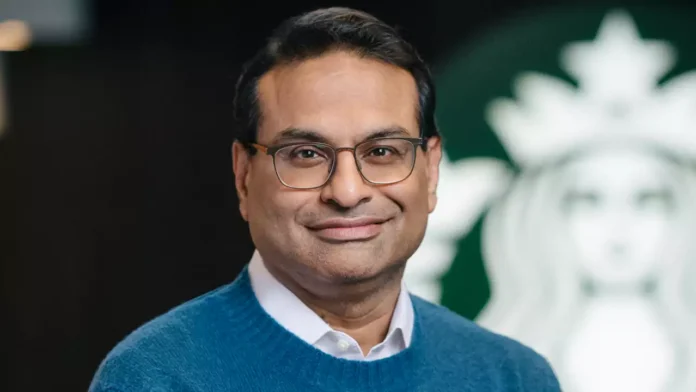Starbucks CEO Laxman Narasimhan has announced plans to open a new store in India every third day, aiming to establish 1000 cafes by 2028. He expressed confidence in the growth potential of the tea-drinking nation, citing its impressive development and enhanced ease of doing business.
“It is really impressive when you look at the investments in infrastructure, you look at the building that is taking place, you look at how there’s a digital revolution. The government is focused on eliminating some of the friction that does exist in areas like business or taxation and how they lean in to support businesses that are looking to invest in the country,” shared Narasimhan during his first visit to India since taking over the helm last March.
The largest coffee retailer globally, in collaboration with Tata Consumer for its Indian operations, achieved a milestone in FY23 by surpassing the INR 1,000-crore sales mark. With 390 stores, this achievement comes more than a decade after the company established its presence in the country in 2012.
“The question is not was the last decade India’s (sic). The question is how do you think of this long term going forward? And I think India has everything in place today to really accelerate its trajectory, even further going forward, which is why we are bullish on India,” stated Narasimhan, who has prior experience with Reckitt, PepsiCo, and McKinsey. He emphasized that coffee penetration in India is notably low compared to many developed markets, citing China’s example where 6,000 stores were opened over the past 25 years.
Much like China, India boasts tens of thousands of small tea shops where locals indulge in sipping tea at prices as low as INR 5 throughout the day. However, in contrast to China, where Starbucks had to generate awareness about coffee to appeal to tea-drinking consumers, the Indian preference has shifted gradually. This transformation was facilitated by the presence of Cafe Coffee Day, a rival to Starbucks, which established as many as 1,250 cafes before the American chain made its entry.
Even with Starbucks’ vigorous expansion efforts in China, the per capita consumption stands at only 12 cups, a stark contrast to Japan and the US, where the figures are 280 and 380 cups respectively.
“So when I look at India, you see a penetration of coffee of about 25%, which is lower than what it is in China, which is at about 40%. I think we are at the start of something special in India.”
Additionally, cafes enjoy global profitability due to a prevalent take-away culture that enhances margins with minimal costs. However, India presents a contrast, as a significant number of office-goers and students prefer ordering a cup of coffee for relaxation, utilizing cafes as spaces where they can spend extended hours. Moreover, the high costs associated with real estate in India necessitate a higher per square foot realization from each customer.
Rising Competition: Starbucks Faces New Players in India
More recently, the market has witnessed the entry of new players such as Pret a Manger, Tim Hortons, and Third Wave Coffee, all of whom are expediting the opening of stores in the country. Tim Hortons, a Canadian coffee chain, inaugurated its initial outlet in India over a year ago, with plans to establish more than 100 stores in the next three years. The British coffee and sandwich chain Pret A Manger also entered the Indian market by launching its first shop in Mumbai last year, as part of a franchise agreement with Reliance Brands Limited, aiming to introduce up to 100 stores over the next five years. Additionally, Third Wave Coffee has already surpassed the milestone of 100 stores.
Continue Exploring: Reliance ventures into the coffee industry with the opening of Pret A Manger’s first shop in Mumbai
“Competition is always good because it makes you sharper. But we are not just going to sit down and just take it lying down. We are building muscles, we are investing in this business. We have areas of differentiation and distinctiveness. We have a base with customers already today with a brand that’s extremely well known. And with Tatas and us fully backing what we do in India, our ambitions for India are large,” said Pune born Narasimhan adding that being from South India, he grew up with a coffee culture with his mother making one of the best coffees in the world.
“I have taken my mother to Starbucks, which she loves, she really does.”
Starbucks’ approach to menu innovation in India underscores the escalating competition. The introduction of masala chai and filter coffee, along with a menu overhaul featuring Indianized and budget-friendly options, reflects the brand’s strategy to attract a broader consumer base. This revamped menu encompasses street-style freshly assembled sandwiches, milkshakes, bite-sized snacks, and a reduced-size beverage cup. Additionally, Starbucks Reserve’s whole bean coffee, Monsooned Malabar from India, is set to be available at both Starbucks Reserve stores in India and the United States later this year. Despite achieving its fastest store expansion in the last fiscal year with the addition of 71 stores, the Seattle-based coffee chain is not solely relying on store counts to transform its fortunes.
Continue Exploring: Starbucks heightens focus on rapid expansion and affordability in India amidst rising competition
“We are not just going to be crazy by just opening stores. I think the big myths in many markets is when people start putting store counts ahead of building a business that is deep and sustainable. And that sticks. I have seen many markets around the world, where you have people who say I am going to open these many thousands of stores. And very soon you will find three or four years later, they will close a whole bunch of them. We grow in a systematic manner to build a special brand and experiences,” he added.





